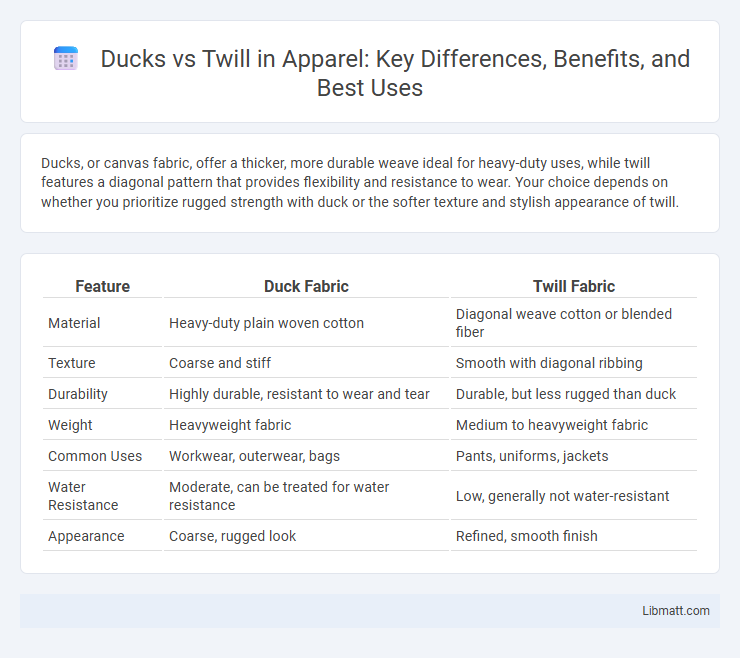Ducks, or canvas fabric, offer a thicker, more durable weave ideal for heavy-duty uses, while twill features a diagonal pattern that provides flexibility and resistance to wear. Your choice depends on whether you prioritize rugged strength with duck or the softer texture and stylish appearance of twill.
Table of Comparison
| Feature | Duck Fabric | Twill Fabric |
|---|---|---|
| Material | Heavy-duty plain woven cotton | Diagonal weave cotton or blended fiber |
| Texture | Coarse and stiff | Smooth with diagonal ribbing |
| Durability | Highly durable, resistant to wear and tear | Durable, but less rugged than duck |
| Weight | Heavyweight fabric | Medium to heavyweight fabric |
| Common Uses | Workwear, outerwear, bags | Pants, uniforms, jackets |
| Water Resistance | Moderate, can be treated for water resistance | Low, generally not water-resistant |
| Appearance | Coarse, rugged look | Refined, smooth finish |
Introduction to Ducks and Twill
Ducks, often referred to as canvas duck, are a heavy, plain-woven fabric known for their durability and water resistance, commonly used in workwear and outdoor gear. Twill, characterized by its distinctive diagonal weave pattern, offers a softer texture and increased flexibility, often favored in fashion and upholstery for its aesthetic appeal. Understanding the differences between ducks and twill helps you choose the right fabric based on durability and style requirements.
Defining Duck Fabric
Duck fabric, also known as canvas duck, is a heavy, plain-woven cotton textile characterized by its tight weave and durability. Unlike twill, which features a diagonal rib pattern due to its unique weaving technique, duck's weave is smoother and more uniform, making it resistant to tears and water. Choosing duck fabric provides You with a sturdy, long-lasting material ideal for heavy-duty applications such as workwear, bags, and outdoor gear.
What is Twill?
Twill is a distinctive fabric weave characterized by a diagonal rib pattern created through the weaving process, which enhances durability and texture. It is commonly used in apparel and home textiles due to its resistance to wrinkles and ability to hide stains better than plain weaves. Twill fabrics, such as denim and chino, offer both aesthetic appeal and practical strength, differentiating them from smoother, less textured fabrics like ducks.
Historical Background: Ducks vs Twill
Ducks and twill are both durable woven fabrics with rich historical significance rooted in textile manufacturing. Duck fabric, often referred to as canvas, originated in the 17th century and was traditionally made from cotton or linen, prized for its heavy-duty, plain weave structure that provided strength and water resistance. Twill, identifiable by its distinctive diagonal weave pattern, dates back to ancient civilizations and gained prominence during the Industrial Revolution for its balance of durability and flexibility, commonly used in denim and workwear.
Weave Structure Comparison
Ducks fabric features a plain weave structure characterized by tightly interlaced fibers providing durability and resistance to wear, ideal for heavy-duty applications. Twill weave displays a distinct diagonal rib pattern, achieved by floating warp or weft threads, enhancing flexibility and drape while maintaining strength. Understanding these weave differences helps you select the appropriate textile for your specific project needs.
Durability and Strength Differences
Ducks fabric is known for its exceptional durability and strength, made from tightly woven cotton fibers that resist wear and tear, making it ideal for heavy-duty applications. Twill fabric features a distinctive diagonal weave pattern that enhances its strength and offers better wrinkle resistance, but it is typically lighter and less robust compared to duck canvas. While duck excels in toughness and longevity, twill balances durability with a softer texture and greater flexibility.
Common Uses for Duck and Twill
Duck fabric is commonly used for heavy-duty items like workwear, tote bags, and upholstery due to its tightly woven, durable nature. Twill fabric, characterized by its diagonal weave, is favored for clothing such as jeans, chinos, and jackets because of its flexibility and resistance to wrinkles. You can choose duck for rugged applications requiring strength, while twill suits everyday garments needing comfort and style.
Aesthetic and Texture Variations
Ducks fabric features a stiff, canvas-like texture with a matte finish, providing a rugged and durable aesthetic commonly used for workwear and casual outerwear. Twill fabric displays a distinctive diagonal weave pattern that creates a smooth, slightly lustrous surface, offering a refined and polished look ideal for suits and dress pants. Variations in weave density and fiber content further influence the tactile experience, with duck typically feeling heavier and coarser compared to the softer, more flexible twill.
Care and Maintenance Factors
Ducks fabric, known for its tightly woven cotton fibers, requires regular washing and air drying to maintain its durability and resist mildew. Twill, characterized by its diagonal weave and smoother surface, benefits from gentle machine washing and ironing to preserve its texture and prevent fading. Both materials benefit from spot cleaning and proper storage in dry environments to extend their lifespan and maintain appearance.
Choosing Between Duck and Twill: Which is Best?
Choosing between duck and twill fabric depends on your project's durability and texture needs. Duck fabric is a heavy, tightly woven cotton canvas ideal for robust applications like workwear and outdoor gear, while twill features a distinctive diagonal weave that offers softness and flexibility suitable for everyday clothing and upholstery. Your choice should reflect whether you prioritize toughness and water resistance with duck or comfort and drape with twill.
Ducks vs twill Infographic

 libmatt.com
libmatt.com